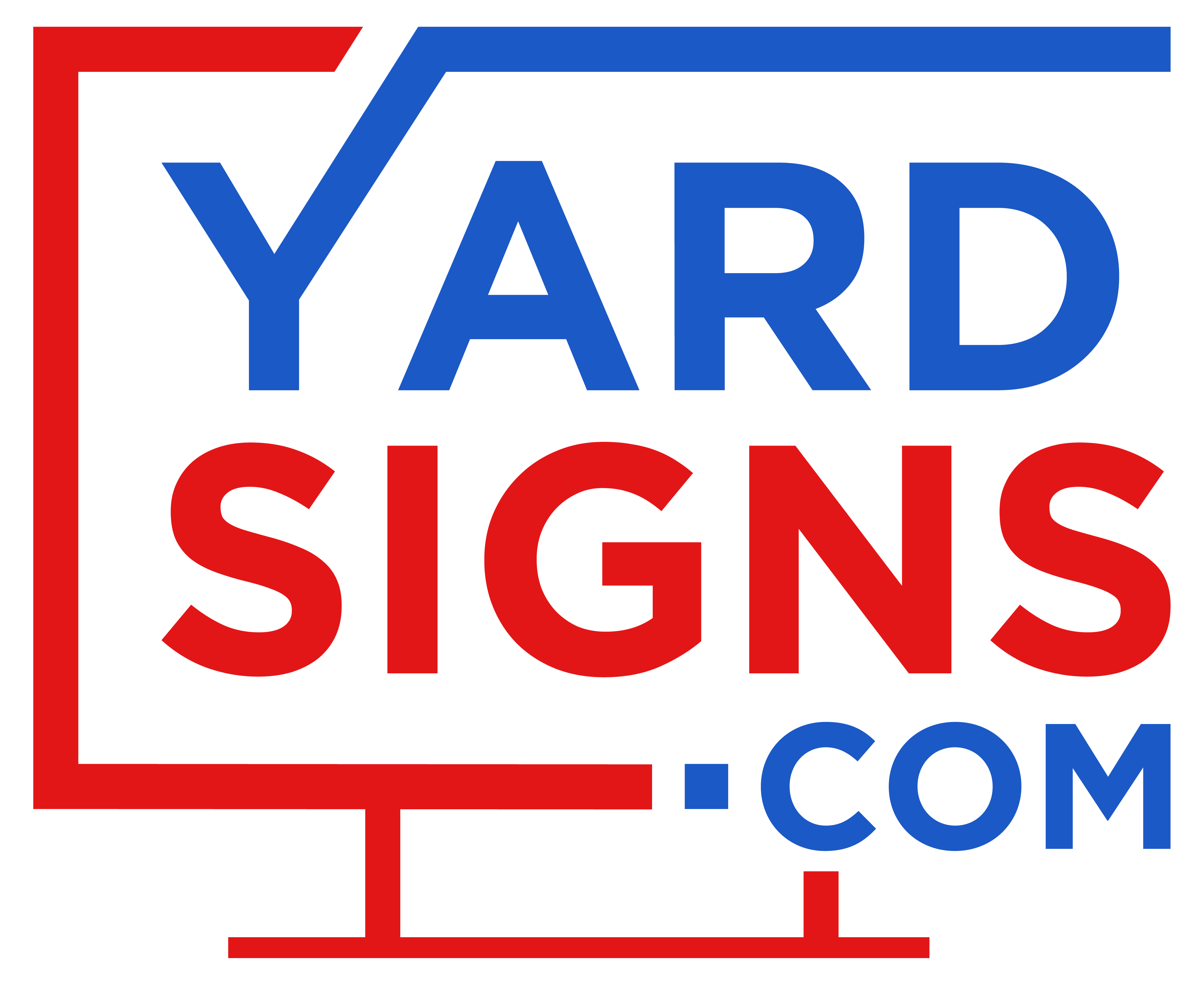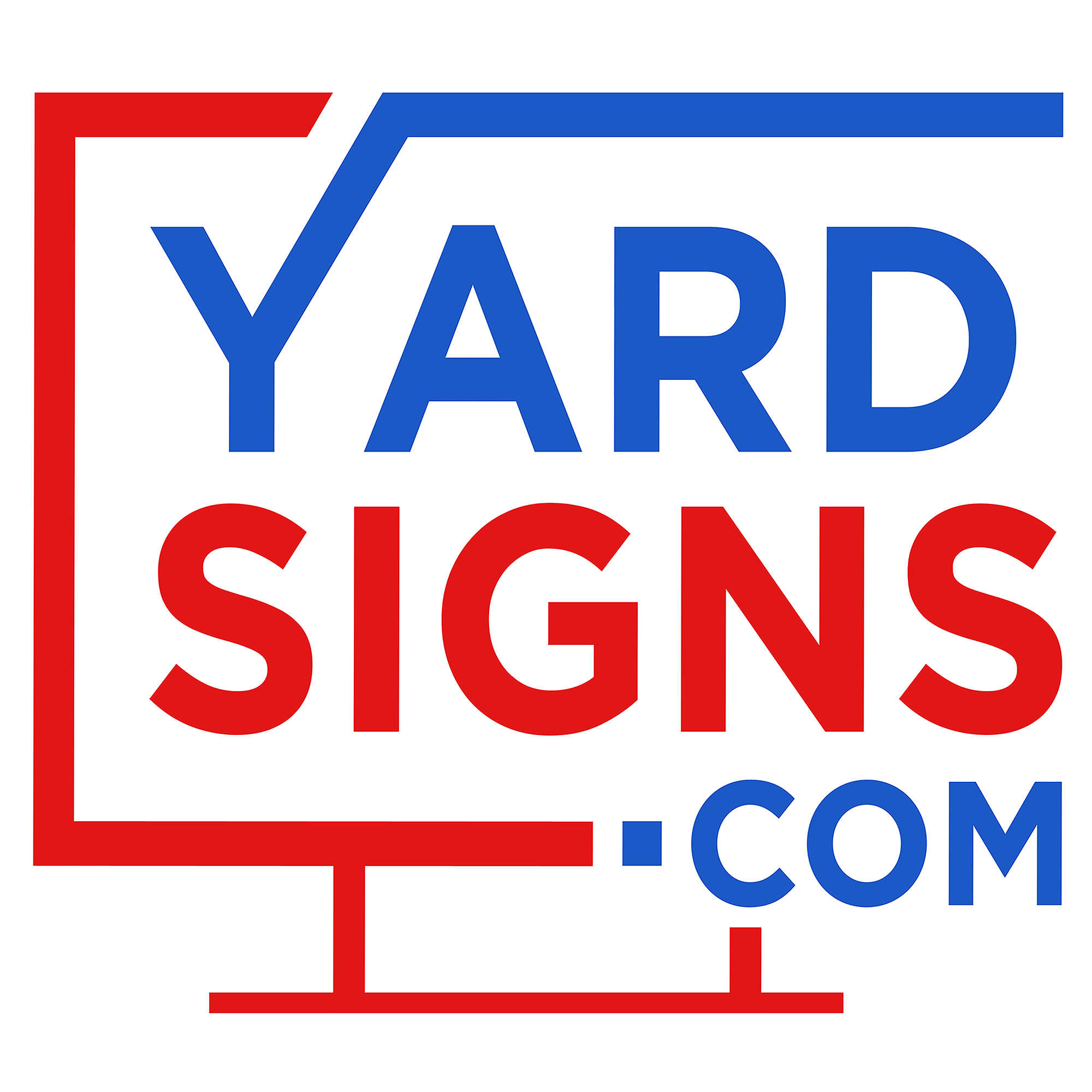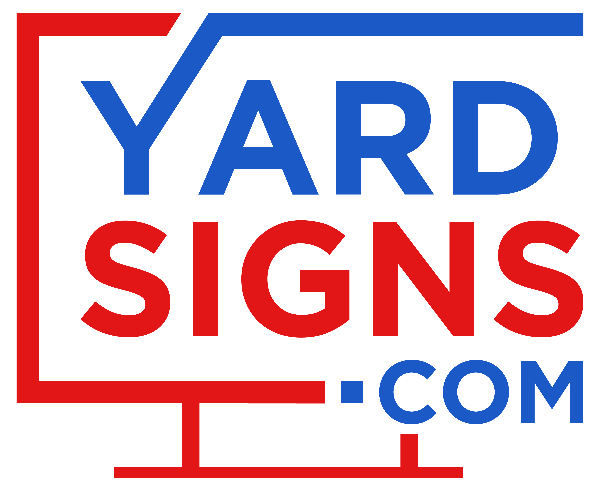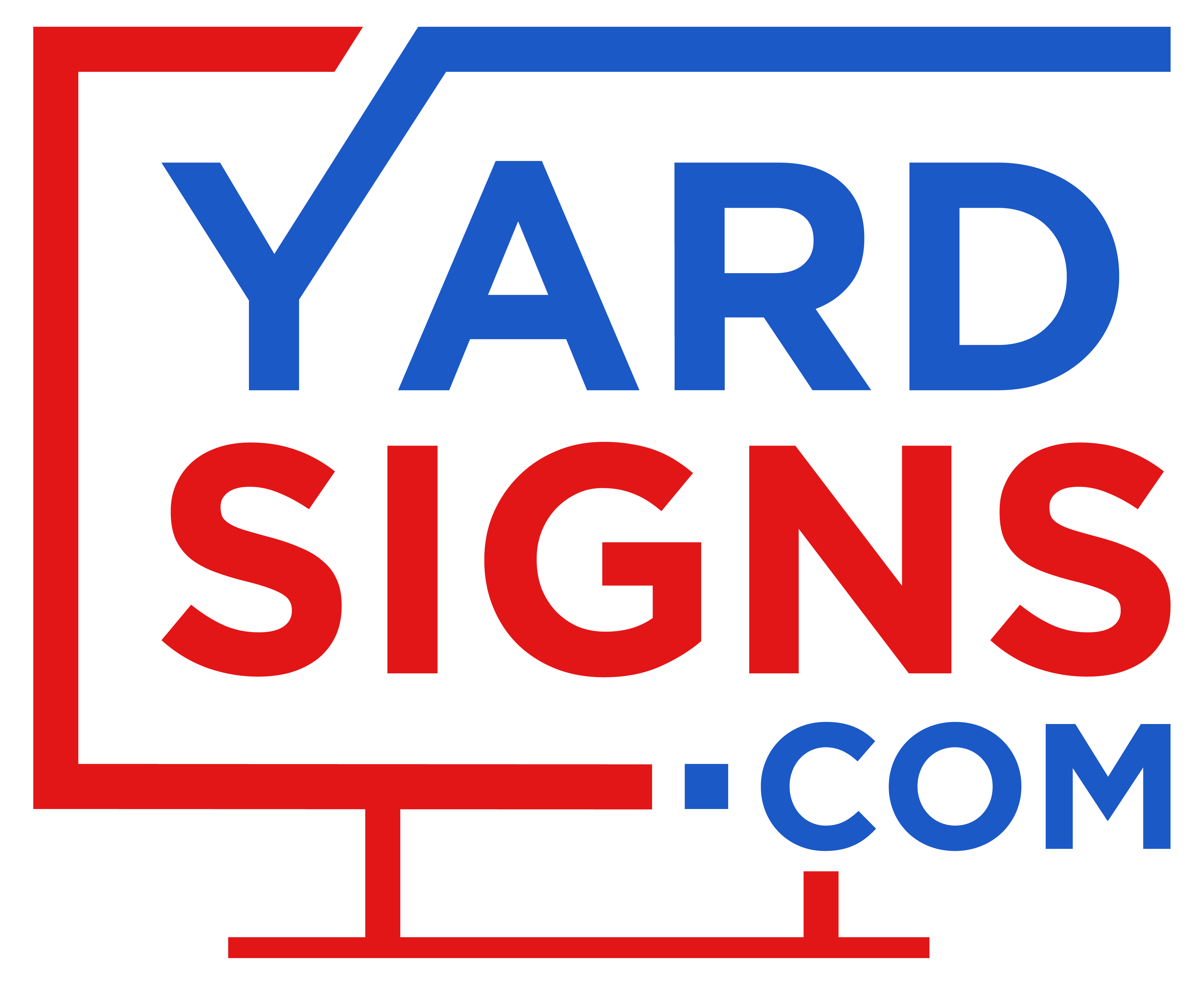Corrugated yard signs are one of the most common types of temporary signage used outdoors. They are often seen during election seasons, real estate listings, or local events. These signs are known for being lightweight, easy to print, and simple to install.
Their design and material make them different from other types of signs. Most are made from a type of plastic with a fluted or ribbed inner layer. This gives the sign structure while keeping it light.
This article explains how corrugated yard signs are made, what materials are used, and how they compare to other signs. It also covers where they are used, how to install them, and how to care for them properly.
What Are Corrugated Yard Signs?

Corrugated yard signs are outdoor signs made from corrugated plastic, commonly known as Coroplast. The name “corrugated” refers to the fluted structure—two flat plastic sheets with hollow channels running between them. These parallel channels create a ribbed internal design that makes the sign strong without adding much weight.
The material used is a type of polypropylene plastic that resists water and UV damage. Standard corrugated yard signs are typically 4 millimeters thick and can be printed on one or both sides. This thickness provides enough rigidity for outdoor use while keeping the sign lightweight and easy to handle.
Common sizes include 18”x24” and 24”x36”, though custom dimensions are available. The vertical flutes in the design serve an important purpose—they allow wire stakes to slide in easily for ground installation.
Key Features:
- Fluted Design: Hollow channels between two plastic sheets give strength while reducing weight
- Material: Made from weatherproof polypropylene plastic
- Thickness: Typically 4mm (about 1/6 inch)
- Standard Sizes: 18”x24” for residential areas, 24”x36” for higher visibility locations
Why Corrugated Yard Signs Are Weather Resistant?
Corrugated yard signs stand up to outdoor conditions better than many other sign materials. The polypropylene plastic used in these signs is naturally waterproof, meaning rain, snow, and morning dew won't soak in or cause the sign to warp. Unlike cardboard or paper-based signs, corrugated plastic maintains its shape even after repeated exposure to moisture.
The printing process for these signs uses UV-resistant inks. These specialized inks resist fading from sunlight exposure, helping the colors stay bright and the message remain readable for months. Without this UV protection, outdoor signs can quickly become faded and difficult to read.
Temperature changes don't easily damage corrugated plastic. The material can handle both summer heat and winter cold without cracking or becoming brittle. This temperature stability makes these signs practical for year-round use in most climates.
Weather Protection Features:
- Waterproof Material: Prevents warping and deterioration from rain or snow
- UV-Resistant Inks: Keeps colors from fading quickly in direct sunlight
- Temperature Tolerance: Remains stable in both hot and cold conditions
Key Benefits Of Corrugated Plastic Signs
Lightweight and Portable
Corrugated yard signs typically weigh less than half a pound per square foot. This lightweight quality comes from the hollow fluted channels that reduce material while maintaining structural integrity. A standard 18”x24” sign weighs approximately 8-10 ounces, making it easy for one person to carry multiple signs at once.
The light weight makes these signs particularly useful for campaigns or events that require placing many signs in different locations. Real estate agents, political campaigns, and event organizers can easily transport dozens of signs in a single trip without needing special equipment.
Durable and Impact Resistant
Despite being lightweight, corrugated plastic signs are surprisingly tough. The fluted structure absorbs impacts and prevents the sign from creasing or tearing easily. When a corrugated sign is hit or bent, it tends to flex rather than break, then return to its original shape.
This durability extends to wind resistance when properly installed. The combination of flexible material and secure staking helps these signs stay upright in moderate wind conditions. Unlike paper signs that tear or foam signs that snap, corrugated plastic bends with the wind and recovers.
Cost Effective for Bulk Orders
Corrugated yard signs offer excellent value, especially when ordered in quantity. The manufacturing process is efficient, and the raw materials are relatively inexpensive. This makes them approximately 30-50% less expensive than aluminum or wood alternatives of similar size.
For organizations needing dozens or hundreds of signs, the savings become significant. Political campaigns, real estate companies, and event promoters often choose corrugated signs specifically for their budget-friendly nature when large quantities are needed.
Popular Applications for Coroplast Signs
Real Estate and Property Promotions

Real estate professionals rely heavily on corrugated yard signs to market properties and direct potential buyers. These signs typically include the agent's name, contact information, and property status (For Sale, Open House, Sold, etc.). The standard 18”x24” size is perfect for residential streets, providing visibility without overwhelming the property's appearance.
Double-sided printing allows the sign to be read from either direction, maximizing exposure to passing traffic. Real estate yard signs often use metal H-frames rather than simple stakes, providing extra stability for long-term placement. The weatherproof quality ensures the sign remains presentable throughout the selling process, which may take weeks or months.
Political Campaigning

During election seasons, corrugated yard signs become ubiquitous in neighborhoods and along roadways. Candidates use these signs to build name recognition and show community support. Political signs typically feature bold colors, the candidate's name, the position sought, and sometimes a brief slogan or campaign logo.
The ability to produce large quantities at reasonable costs makes corrugated signs ideal for political campaigns with limited budgets. Volunteers can easily distribute and install hundreds of signs across a district. The standard size for political yard signs is 18”x24”, though larger sizes may be used in high-traffic areas for increased visibility.
Community Events and Celebrations

Local events rely on corrugated signs for promotion and direction. From school fundraisers to community festivals, these signs help spread the word and guide attendees. Event signs typically include the event name, date, time, location, and sometimes directional arrows or additional information.
The temporary nature of most events aligns perfectly with the lifespan of corrugated signs. Organizations can use the signs for the weeks leading up to an event, then either store them for future use or recycle them afterward. The ability to create custom shapes and sizes also allows for more creative designs that stand out from standard rectangular signs.
Home Services and Local Businesses

Small businesses, particularly in the home service industry, frequently use corrugated yard signs for local advertising. Lawn care companies, painters, pressure washing services, and contractors place signs at job sites to generate referrals from neighbors. These signs typically include the business name, phone number, website, and a brief description of services.
The low cost per sign makes this form of advertising particularly effective for small businesses with limited marketing budgets. A single job can generate multiple leads if the sign attracts attention from neighbors. Many service businesses report that yard signs produce better local results than more expensive advertising methods.
How To Install And Display Yard Signs Outdoors
Using Step Stakes
Step stakes are the most common method for installing corrugated yard signs in soft ground. These metal wire supports have an H-like shape with prongs at both ends. The top prongs slide into the vertical flutes of the sign, while the bottom prongs push into the soil.
To install a sign with step stakes:
- Insert the upper prongs of the stake into the fluted channels of the sign
- Position the sign at the desired location
- Step on the horizontal part of the stake to push it into the ground
- Ensure the sign is level and secure
Standard step stakes work well in most soil conditions, but heavy-duty stakes (made from thicker wire) provide better support in windy areas or harder ground.
Employing Metal Frames
Metal H-frames provide more stability than simple stakes, making them ideal for long-term placement or larger signs. These frames have a horizontal crossbar at ground level that prevents the sign from twisting or leaning. Corrugated signs slide into channels on the frame and are sometimes secured with clips.
H-frames work well on uneven ground or in locations where signs need to remain in place for extended periods. Real estate agents typically use these frames for property listings because they provide a professional appearance and greater durability. The frames can be reused multiple times with different signs.
Attaching To A-Frames
A-frames (also called sandwich boards) allow corrugated signs to be displayed on hard surfaces like sidewalks or parking lots. These foldable stands hold signs on both sides, creating visibility from multiple directions. Corrugated panels attach to the frame using clips, Velcro, or slide-in channels.
This display method is particularly useful for businesses, as A-frames can be placed near entrances or high-traffic pedestrian areas. They can be easily moved or brought indoors during closing hours. The dual-sided nature of A-frames effectively doubles the sign's visibility compared to single-sided displays.
Customization Options and Printing Methods
Corrugated yard signs can be fully customized using modern printing technologies. UV printing is the most common method, applying ink directly to the plastic surface and curing it instantly with ultraviolet light. This creates vibrant colors that resist fading and weathering. Latex printing is another option, using water-based inks with heat curing for environmental friendliness.
Signs can be printed on one side (single-sided) or both sides (double-sided). Double-sided printing costs slightly more but provides visibility from multiple directions. The images on each side can be identical or completely different, depending on the intended use.
Most corrugated signs are rectangular, but custom die-cutting allows for specialized shapes. Arrow-shaped signs, circular designs, or cutouts that follow a logo's outline can make a sign more noticeable. Custom shapes typically cost more than standard rectangles due to the additional production steps.
|
Feature |
Options |
Best Application |
|
Printing |
Single-sided |
One-way visibility (against walls, fences) |
|
Double-sided |
Multi-directional visibility (roadside, open areas) |
|
|
Colors |
Full color |
Photos, gradients, detailed graphics |
|
Limited color |
Simple messages, budget considerations |
|
|
Shape |
Standard rectangle |
Most cost-effective, traditional look |
|
Custom die-cut |
Eye-catching, brand reinforcement |
|
|
Size |
18”x24” |
Residential areas, standard placement |
|
24”x36” |
High-traffic areas, greater visibility |
Comparisons With Other Yard Sign Materials

Plastic Coated Cardboard
Plastic coated cardboard signs (sometimes called polycoated signs) consist of a cardboard core with a thin plastic coating. While less expensive than corrugated plastic, these signs have significant drawbacks for outdoor use. The cardboard core can absorb moisture over time, causing warping and deterioration. Even with the plastic coating, these signs typically last only a few weeks in wet conditions.
The print quality on plastic coated cardboard can be quite good initially, but the signs lack the structural integrity of corrugated plastic. They bend more easily and can crease permanently if mishandled. For very short-term indoor use or one-time events in dry weather, these signs may be adequate, but they don't compare to corrugated plastic for durability.
Foam Board Signs
Foam board consists of a polystyrene foam core sandwiched between paper or plastic facing. These signs are extremely lightweight and provide an excellent smooth surface for high-quality printing. However, they are primarily designed for indoor use.
When placed outdoors, foam board signs quickly deteriorate. The foam core absorbs moisture, causing the facing to bubble or peel. Direct sunlight can warp or yellow the material. Even a light rain can ruin a foam board sign. These limitations make foam board unsuitable for yard signs except for very brief, fair-weather use.
Aluminum And Metal Alternatives
Aluminum signs represent the premium end of the yard sign spectrum. They offer exceptional durability, with lifespans measured in years rather than months. The metal construction resists bending, and the printed graphics can be protected with special coatings for extended outdoor use.
However, aluminum signs cost significantly more than corrugated plastic—often 3-4 times as much. They're also heavier, making transportation and installation more difficult. The added weight requires stronger mounting hardware. For permanent signage needs, aluminum makes sense, but for temporary or seasonal use, the cost difference is hard to justify.
Maintaining And Storing Corrugated Yard Signs
Cleaning And Care
Corrugated yard signs are easy to clean with mild soap and water. A soft cloth or sponge can remove dirt, dust, and light stains without damaging the printed surface. Avoid using harsh chemicals or abrasive scrubbers, as these can scratch the print or degrade the plastic.
For stubborn marks, isopropyl alcohol applied with a soft cloth can help remove residue without damaging the sign. Small scratches or scuffs can sometimes be masked with clear packing tape applied carefully over the damaged area. This simple fix can extend a sign's useful life.
Proper Off-Season Storage
When not in use, corrugated yard signs should be stored flat in a cool, dry place. Stacking signs horizontally prevents warping or bending that can occur if they're leaned against a wall for long periods. Placing a sheet of paper between stacked signs prevents them from sticking together or transferring ink.
Avoid storing signs in extremely hot areas like attics or garages during summer, as high temperatures can cause the plastic to soften and deform. Similarly, keep signs away from direct sunlight during storage to prevent fading. With proper storage, corrugated signs can be reused for multiple seasons or events.
Ready To Make an Impact With Your Outdoor Signage
Corrugated yard signs offer an effective combination of durability, affordability, and visibility for outdoor messaging. Their unique fluted plastic construction makes them weather-resistant while keeping them lightweight and easy to install. Whether for business promotion, event announcements, or property sales, these versatile signs deliver your message clearly.
The customization options available for corrugated signs allow for creative designs that capture attention. Full-color printing, custom shapes, and various sizes help your message stand out. Installation methods like step stakes, H-frames, and A-frames provide flexibility for different placement scenarios.

For high-quality corrugated yard signs with fast, free shipping, visit Yardsigns.com. Their online design tools make creating custom signs simple, and their durable materials ensure your message remains visible in all weather conditions.
Frequently Asked Questions About Corrugated Yard Signs
How long do corrugated plastic yard signs typically last outdoors?
Corrugated plastic yard signs typically last 6-12 months with continuous outdoor exposure. Signs in partial shade or mild climates may last longer, while those in extreme conditions might deteriorate faster.
Can corrugated yard signs be reused for multiple events or seasons?
Yes, corrugated yard signs can be reused if they're properly stored between uses. Clean the signs before storage and keep them flat in a cool, dry place to prevent warping or color fading.
What is the difference between corrugated plastic and Coroplast signs?
There is no functional difference. Coroplast is simply a brand name for corrugated plastic that has become widely used as a generic term in the signage industry, similar to how Kleenex is used for tissues.
Are corrugated yard signs recyclable?
Corrugated plastic yard signs are recyclable in many areas, though not all recycling facilities accept them. The polypropylene plastic (recycling code #5) can be processed at facilities equipped to handle this material.
What size corrugated yard sign is best for visibility from the road?
For visibility from roads with normal traffic speeds, an 18”x24” sign is the minimum recommended size. For busier roads with faster traffic, 24”x36” signs provide better visibility and readability from greater distances.




